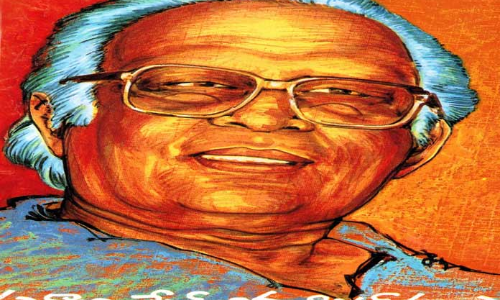Fiddling a dozen ragas

Second fiddle to none, Tikkavarapu Pattabhi Rami Reddy, a meteoric youth, with a scalding expression, entered the placid environs of Telugu literature, at the age of twenty Well educated, from a sound family, already a fan of Chalam and Sri Sri, in 1939, his entry kicked a ruckus, for the young man had changed his name into some sort of a Telegraphic Code PaThaaBhi
Second fiddle to none, Tikkavarapu Pattabhi Rami Reddy, a meteoric youth, with a scalding expression, entered the placid environs of Telugu literature, at the age of twenty. Well educated, from a sound family, already a fan of Chalam and Sri Sri, in 1939, his entry kicked a ruckus, for the young man had changed his name into some sort of a Telegraphic Code ‘PaThaaBhi’. And the cover of this slim volume of poems, carried an endorsement by Chalam, by then, already a sensation in Telugu literature. And inside, meaty poet Sri Sri wrote an intro, wherein he called ‘beauty is weird and weird is beauty’ justifying thus ‘Vichitrame soundaryam soundaryame vichitram’. February 19 was his centennial day.
Violin is also called as Fiddle. With an offbeat name, that announces ‘Fiddle ragas a dozen’ stormy petrel Pattabhi barged into the sensitive and sensuous highs of the Telugu romantic poets (Bhava kavulu and the main members Basavaraju Apparao, Nandoori Subbarao, Devulapalli Krishnasastri, Abboori Ramakrishna Rao, and others). Their stake to poetic success in romantic tones and tunes was already an established trend, which latter-day revolutionary poets like Sri Sri, also acknowledged, to be a sustaining influence on him, particularly, the verse of Krishnasastry. Though younger in the lot, Krishnasastry was considered to be the leader of Bhava Kavulu.
Therefore, in 1939, young poet Pattabhi, declared in his first poem that he was not a Bhava Kavi but an Ahambhava Kavi (Meaning that he is not a romantic poet but an egotist poet). Normally, if some writer names a work ‘aatmakatha’ (biography) it appears in his ripe age. But this young poet named his very first poem ‘Atmakatha’ and was more than candid when he stated that he would punish Chinnaya Suri for his Bala Vyakarana, which had focused only on the old form of metrical verse. And Pattabhi turned a sensation when he went on to state that he would “hit the padyas on the back”. This was though uncharitable; the Telugu community took the expression as a prank by a rebellious voice. The statement of facts, by Pattabhi in his dozen songs, ranged from proclaiming that he belonged to a new class of poets, and he also experimented in the de-spelling the Telugu word. Thus, in his poem ‘Fiddle and Raga’, the last one, the Telugu Gunintham (Spelling pattern) of words was changed drastically, and for the same words, he used new constructions. This remained only an experiment, and that too only by a sole poet. This deconstruction did not appeal to the general creative interest of the poets, then or after. It remained a brand Pattabhi and was a part of his sensational persona.
Like the word ‘calami-terror’ used by George Barker in 1930s, our poet here too was creating fusion words of Telugu and English like ‘High Heel Yaana’ (High heeled woman), ‘Hungry Kanulu’ (Hungry eyes), ‘Prabhata Razor’ (Morning Razor), and lavishly used them in his ‘Fidelu Ragala Dozen’.
The poem about Sita takes an altogether different line, where Rama’s qualities as a loving husband are discussed by Sita and the poet, and both conclude that Ravana would be a better choice, for a justice-seeking woman, than the former. Incidentally, Chalam also in one of his plays, echoed the similar sentiment, where, Sita, at the test by fire situation, rather refers to jump into the pyre of Ravana, who died for her, then satisfying Rama, by proving her virtue by Agni Pravesa (Jumping into the fire). Pattabhi, in the twelve poems, remained a world poet while he describes the natural beauty of Lake Loch Lomund in Scotland.
Pattabhi, after a gap of four decades roughly, brought out the second volume entitled ‘Kayitha Naa Dayitha’, which means that poesy is my woman. Earlier 15th-century poet Pillamarri Pinaveerabhadrudu, said famously ‘Vaani naa raani’ (Sarasvathi is my queen). In this volume, the traditional bondage of Pattabhi came to the fore, when he became the first poet to record in modern times, in Telugu, the moods of Ashta Vidha Nayikas of the Bharateeya tradition.
His other poems about young women in the different parts, also strongly remind one about the ‘Kreedabhiraamamu’ the 15th-century work, where poet Srinatha and Vinukonda Vallabharaya, record the mannerisms and voluptuous nature of different village women. His pun, playing on the acidic quality and pungent nature, collected as ‘Pattabhi Pun Changam’, and all the three works out together as ‘Pattabhi Pelchina Phirangulu’ in 1998 by the Pattabhi Amrutotsava Committee, provided the lovers of literature with a robust book of experimentation. Pattabhi, otherwise, a spokesman for civil rights, opposition to the emergency of 1975, and as a progressive filmmaker of ‘Samksara’ (1970), ‘Chandamarutha’ (1977), etc, with his wife Snehalatha donning the key role in both the films, and in Telugu much earlier as the producer of ‘Pellinaati Pramanalu’ made his mark on the celluloid also as a successful producer. Observing the birth centennial of such a multi-dimensional personality, we need to imbibe into our practical side, his galvanised approach towards the creative realm, be it of letters or of theatre.
- The writer is a bi-lingual poet, translator, critic, columnist and an orator.

